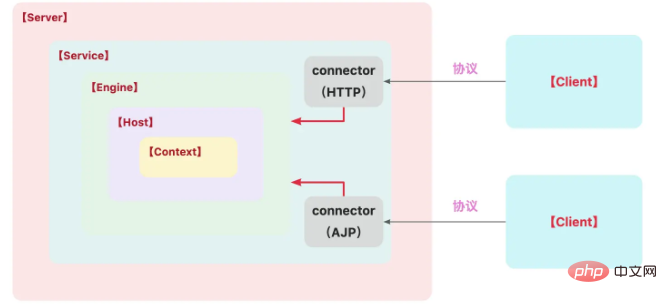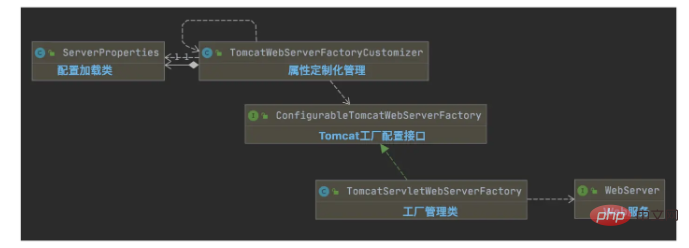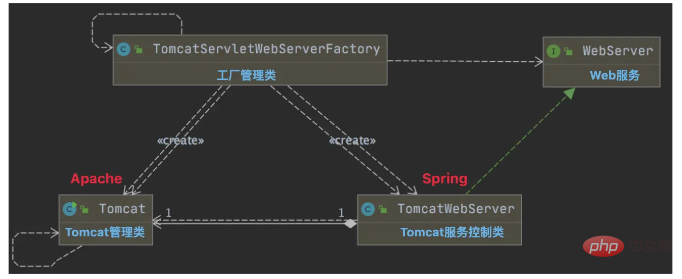
使用的成本越低,内部封装越复杂
在SpringBoot框架的web依赖包中,引入的是内嵌Tomcat组件,基于SpringBoot的版本,Tomcat集成的是9.0版本;
<!-- 1、项目工程依赖 -->
<dependency>
<groupId>org.springframework.boot</groupId>
<artifactId>spring-boot-starter-web</artifactId>
<version>2.2.5.RELEASE</version>
</dependency>
<!-- 2、starter-web依赖 -->
<dependency>
<groupId>org.springframework.boot</groupId>
<artifactId>spring-boot-starter-tomcat</artifactId>
<version>2.2.5.RELEASE</version>
<scope>compile</scope>
</dependency>
<!-- 3、starter-tomcat依赖 -->
<dependency>
<groupId>org.apache.tomcat.embed</groupId>
<artifactId>tomcat-embed-core</artifactId>
<version>9.0.31</version>
<scope>compile</scope>
</dependency>在SpringBoot框架的自动配置类中,Web项目中不显式更换其他服务依赖时,默认提供了对Tomcat服务的管理;
@ConditionalOnWebApplication(type = Type.SERVLET)
@EnableConfigurationProperties(ServerProperties.class)
@Import({ ServletWebServerFactoryAutoConfiguration.BeanPostProcessorsRegistrar.class,
ServletWebServerFactoryConfiguration.EmbeddedTomcat.class})
public class ServletWebServerFactoryAutoConfiguration {
@Bean
@ConditionalOnClass(name = "org.apache.catalina.startup.Tomcat")
public TomcatServletWebServerFactoryCustomizer tomcatServletWebServerFactoryCustomizer(
ServerProperties serverProperties) {
return new TomcatServletWebServerFactoryCustomizer(serverProperties);
}
}
Server:代表整个Tomcat容器;
Service:服务器内部的中间组件,将一个或多个Connector绑定到一个Engine上;
Engine:表示特定服务的请求处理管道,接收Connector的请求并响应;
Host:网络主机名称;
Connector:连接器处理与客户端的通信;
Context:代表一个Web应用程序的上下文;
参考Tomcat9.0版本的核心组件描述,对于框架有大致的了解后,再去分析集成原理,会更容易把握主线逻辑;
在配置文件中,对Tomcat做一些基础性的设置,查看下面的配置类可以知道,这些属性存在默认值;
server:
port: 8082 # 端口号
tomcat: # Tomcat组件
uri-encoding: UTF-8 # URI编码
max-threads: 100 # 最大工作线程
min-spare-threads: 10 # 最小工作线程在服务配置中,提供多种服务器的适配,像Tomcat、Jetty、Netty、Undertow,从策略上看,配置分为公共属性以及各种服务器的适配属性;
更多配置信息,可以参考完整的源码和注释说明;
@ConfigurationProperties(prefix = "server", ignoreUnknownFields = true)
public class ServerProperties {
private Integer port;
public static class Tomcat {
private Charset uriEncoding = StandardCharsets.UTF_8;
private int maxThreads = 200;
private int minSpareThreads = 10;
}
}
基于配置的属性,定制化管理Tomcat服务的信息;
public class TomcatWebServerFactoryCustomizer
implements WebServerFactoryCustomizer<ConfigurableTomcatWebServerFactory> {
@Override
public void customize(ConfigurableTomcatWebServerFactory factory) {
ServerProperties properties = this.serverProperties;
ServerProperties.Tomcat tomcatProperties = properties.getTomcat();
PropertyMapper propertyMapper = PropertyMapper.get();
customizeStaticResources(factory);
}
}TomcatWeb服务工厂,这里在创建WebServer时,使用的是Tomcat,需要适当的了解一下Tomcat架构;
public class TomcatServletWebServerFactory extends AbstractServletWebServerFactory
implements ConfigurableTomcatWebServerFactory, ResourceLoaderAware {
@Override
public WebServer getWebServer(ServletContextInitializer... initializers) {
Tomcat tomcat = new Tomcat();
Connector connector = new Connector(this.protocol);
connector.setThrowOnFailure(true);
tomcat.getService().addConnector(connector);
customizeConnector(connector);
tomcat.setConnector(connector);
tomcat.getHost().setAutoDeploy(false);
configureEngine(tomcat.getEngine());
prepareContext(tomcat.getHost(), initializers);
return getTomcatWebServer(tomcat);
}
}
WebServer的简单接口,只声明端口获取,服务启动和停止相关方法;
public interface WebServer {
// 获取监听的端口
int getPort();
// 服务启动
void start() throws WebServerException;
// 服务停止
void stop() throws WebServerException;
}SpringBoot中,Tomcat服务核心控制类,通过TomcatServletWebServerFactory工厂类创建,对Tomcat生命周期的管理提供了一层包装;
public class TomcatWebServer implements WebServer {
private final Tomcat tomcat;
private final Map<Service, Connector[]> serviceConnectors = new HashMap<>();
}Apache组件中,轻量级Tomcat启动器,提供了Tomcat基础配置,比如默认的Port和HostName,以及生命周期管理的方法,TomcatWebServer类中调用的就是该API中的具体方法;
public class Tomcat {
protected Server server;
protected int port = 8080;
protected String hostname = "localhost";
// 初始化服务
public void init() throws LifecycleException {
getServer();
server.init();
}
// 启动服务
public void start() throws LifecycleException {
getServer();
server.start();
}
// 停止服务
public void stop() throws LifecycleException {
getServer();
server.stop();
}
}2.1 初始化,初始化时,调用Apache-Tomcat类中启动方法;
public class TomcatWebServer implements WebServer {
/**
* 初始化方法
*/
private void initialize() throws WebServerException {
// 控制台日志
logger.info("Tomcat initialized with port(s): " + getPortsDescription(false));
synchronized (this.monitor) {
// 调用Apache-Tomcat类中启动方法
this.tomcat.start();
}
}
}2.2 启动,在初始化的方法中,调用的Tomcat启动方法,这里对状态进行校验并输出日志;
public class TomcatWebServer implements WebServer {
/**
* 启动方法
*/
public void start() throws WebServerException {
synchronized (this.monitor) {
if (this.started) {
return;
}
checkThatConnectorsHaveStarted();
// 启动状态的标识
this.started = true;
// 控制台日志
logger.info("Tomcat started on port(s): " + getPortsDescription(true) + " with context path '"
+ getContextPath() + "'");
}
}
}2.3 停止,在组件生命周期的常规管理逻辑中,停止服务之后进行销毁动作的执行,其中自然涉及到多个状态标识的转换;
public class TomcatWebServer implements WebServer {
/**
* 停止方法
*/
public void stop() throws WebServerException {
synchronized (this.monitor) {
// 状态变化
boolean wasStarted = this.started;
this.started = false;
// Tomcat服务停止
stopTomcat();
this.tomcat.destroy();
}
}
}Ce qui précède est le contenu détaillé de. pour plus d'informations, suivez d'autres articles connexes sur le site Web de PHP en chinois!
 Étapes de création du projet SpringBoot
Étapes de création du projet SpringBoot
 Comment configurer les variables d'environnement Tomcat
Comment configurer les variables d'environnement Tomcat
 Comment intégrer l'idée avec Tomcat
Comment intégrer l'idée avec Tomcat
 Comment afficher le code source de Tomcat
Comment afficher le code source de Tomcat
 Quelles sont les vulnérabilités courantes de Tomcat ?
Quelles sont les vulnérabilités courantes de Tomcat ?
 Comment résoudre les journaux Tomcat tronqués
Comment résoudre les journaux Tomcat tronqués
 Quelles sont les différences entre weblogic et Tomcat
Quelles sont les différences entre weblogic et Tomcat
 Quelles sont les différences entre Tomcat et Nginx
Quelles sont les différences entre Tomcat et Nginx